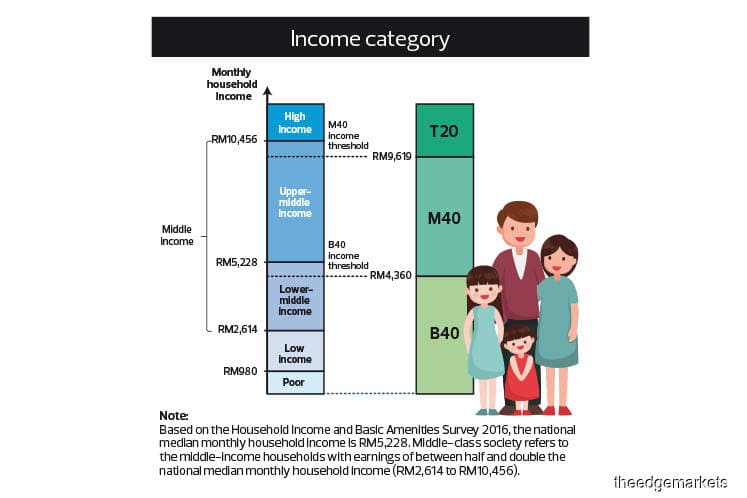
This article first appeared in The Edge Malaysia Weekly on February 24, 2020 - March 1, 2020
MIDDLE-class society is seen globally as the aspirational group of society that can afford more than their basic needs. They have been defined and measured in many ways across the globe, where some have used consumption metric, aspiration levels and wealth measurement.
However, many also adopt the income metric to define the middle class.
Under the Mid Term Review of the 11th Malaysia Plan (MTR), the middle-class group refers to middle-income households with earnings of between half and double the national median monthly household income.
Therefore, by this definition, the middle class in Malaysia are those with a monthly household income of RM2,614 to RM10,456. This is based on the Household Income and Basic Amenities Survey 2016, where the national median monthly household income stood at RM5,228.
Recall that the MTR breaks down the segments further, classifying the B40 (Bottom 40%) as those with household income of less than RM4,360 per month, M40 (Middle 40%) with household income between RM4,360 and RM9,619, while the T20 (Top 20%) with household income of more than RM9,619.
However, the M40 definition for a household of four that earns RM4,360 to RM9,619 per month in the Klang Valley would hardly fall into the “aspirational” category that the middle class is often associated with.
Khazanah Research Institute (KRI) in its recent study “Are both the B40 and M40 ‘poor’?” found that a high proportion of the M40 group in the country showed similar consumption patterns with the top end of the B40 group. This shows that they are far from the aspirational or middle-class households that should represent a significant part of society in the country.
“Households in this middle 50% group were experiencing a spectrum of trade-offs in their choice to consume. These trade-offs are not between ballet classes and short holidays to Bali, but more of consuming more varieties of basic needs.
“We found that households mainly purchased more varieties of food and household furniture. There is a clear broadening of consumption choices. Only when we move further up the scale [do] payments for ‘aspirational goods’ (such as after-school private tutoring) begin to feature more frequently,” says the study.
The definition of the M40 needs a revision, economists agree.
“These figures need to be revised to reflect the cost of living, living wage, inflation, size of family and location. It needs to provide a deeper understanding of poverty and economic conditions by incorporating the effects of cost of living, household size, government incentives, subsidies, assistance programmes, educational background, work expenses and medical costs,” says Academy of Sciences Malaysia fellow Dr Madeline Berma.
It is worth noting that the B40, M40 and T20 thresholds change with the country’s gross national income, says Sunway University Business School professor of economics Dr Yeah Kim Leng.
It does not take into account, however, the household size nor the cost of living that varies across states and locations.
“The extent to which the current thresholds or median income for M40 group is adequate will depend on these two factors: household size and cost of living,” adds Yeah.
He says the living wage concept and measurement introduced by Bank Negara Malaysia is a functional approach to defining more accurately the economic realities that Malaysian households face. Bank Negara in its 2018 annual report said the living wage of a couple with two children in the Klang Valley, based on provisional income of 2016, was RM6,500.
The living wage is the minimum income of a household so that they can afford an acceptable standard of living.
“Extending the study to the rest of the country will be necessary to better define what income range constitutes ‘middle class’ in Malaysia,” Yeah adds.
Studies and research have found that countries with a strong and prosperous middle class report stronger economic growth. This is because a strong middle class helps generate demand for aspirational goods and services besides being an important element in nurturing small and medium enterprises and spurring the entrepreneurial sector.
“In particular, middle classes generally invest heavily in their own education and that of their children, thus increasing the current and future stock of human capital. Human capital accumulation is therefore an important channel through which a strong middle class can support well-being and GDP per capita growth, as it boosts that share of population with secondary and tertiary education,” says the Organization for Economic Co-operation and Development in its report “Under Pressure: The Squeezed Middle Class”.
KRI highlights in its report that the middle class is crucial to stimulating the demand for local consumption, owing to its stable economic standing.
“There is a need to focus on expanding the aspirational group as part of the Shared Prosperity Vision 2030 and as an economic basis to propel our nation forward,” notes KRI.
Save by subscribing to us for your print and/or digital copy.
P/S: The Edge is also available on Apple's AppStore and Androids' Google Play.